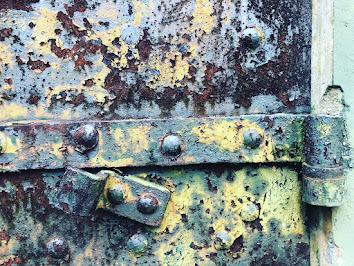Arriving at Fort Worden sent me on a hunt about fortification history and architecture. Following trails through the woods to the top of Artillery Hill, Paul and I encounter the ramparts, solidly built gun emplacements known here as “batteries.” “Bulwark” is another term that feels related to the work from my first week at Centrum: large pencil drawings of entangled old growth cedar and spruce branches and roots. The “bul-” part of bulwark is related to bole, “tree trunk,” while -wark is related to English work, wrought, and wright.
The last of the guns at the fort were removed in 1945, and the defunct battery enclosures, tunnels, stairwells, rusting doors and pipes, lichen-stained concrete, a stately sign with the name, Cornelius Tolles, a captain who died from his wounds in a Civil War battle—comprise these eerie tombs. We start to hymn and sing into the dark reverberating chambers. “What a performance venue!”, our eyes circling in their sockets as we imagine the possibilities.
Maybe the visions of performing in this unique place lead us to attend an improv dance class at the Fort’s Madrona MindBody. The instructor, Ashley Friend, facilitates a combination of guided modern dance, ballet, full-body self-expression, gesture, and motion, in a welcoming atmosphere of discovery. What happens if we travel in a straight line while pushing, pulling, or reaching, and happen to meet another dancer? Turn 90 degrees to change direction and continue on. It’s been decades since I danced like this. It's exciting, full of possibilities. Class ends and we don’t want it to be over. Ashley, and two local dancers, Angela and Camille, and Paul and I stay sprawled on the smooth floor to talk until it grows dark. We share about opportunities that life handed us in the past when we chose to turn away, often due to a lack of confidence or mature judgment at the time, and which made us take another path.
After the first week of drawing, and taking breaks to bike the wooded trails and Victorian-era streets downtown, I transition to part two: working digitally, overlaying the drawings with my photos shot in the forest and the batteries, discovering how the pencil lines can look as if drawn directly on the surfaces of the bulwarks, reinforcing sharp angles, deep orifices, shadows, and variegated textures, and enhancing the already strangely enigmatic atmosphere.



Comments
Post a Comment